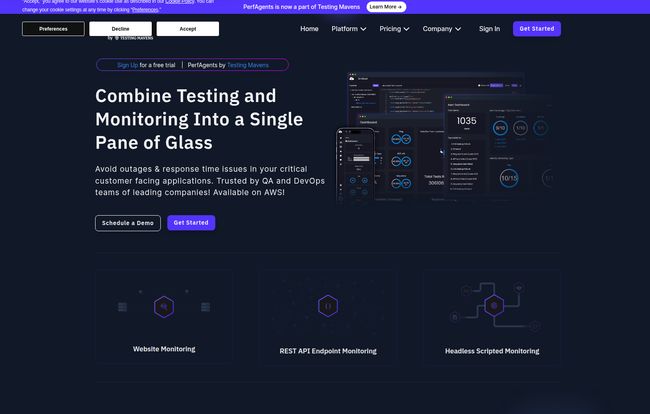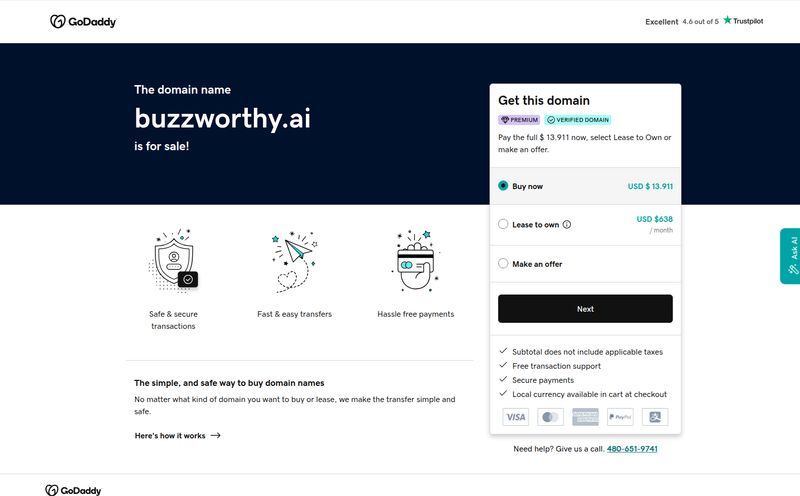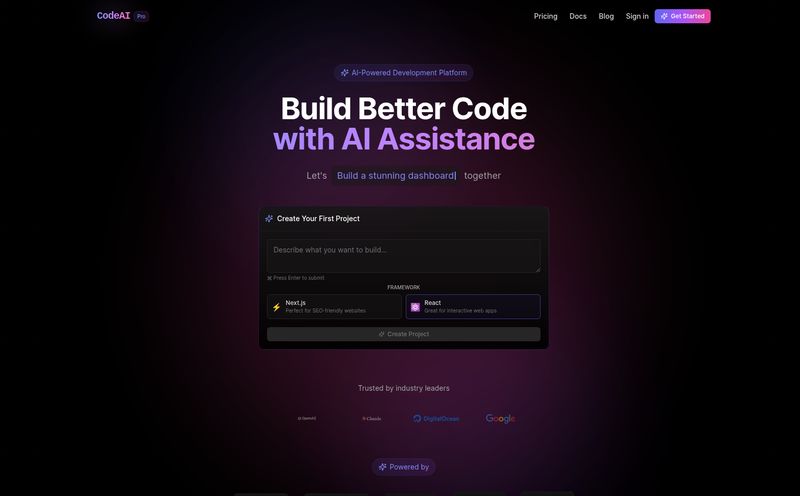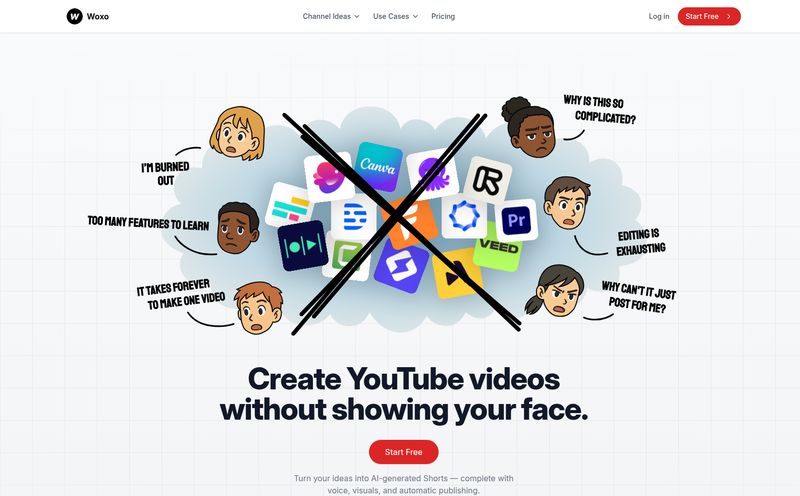I still have mild PTSD from a launch day back in 2018. The dev team had run all their tests—everything passed with flying colors. We push to production, pop the champagne, and then… crickets. The site was up, but a critical checkout API was failing silently. Our monitoring tools said “All Systems Go!” because they were just pinging the homepage. It took us hours to figure it out, and the sales lost were, let's just say, significant.
That nightmare scenario is why the DevOps world has been chasing the holy grail of unified testing and monitoring for years. We've all talked about it. We’ve all tried to hack it together with a mess of scripts and dashboards. So, when a platform like PerfAgents comes along with the bold claim of combining testing and monitoring into a “single pane of glass,” my cynical old-school SEO heart skips a beat. Their tagline is even cheekier: “Built for 2026, not 2014.” Okay, PerfAgents. You have my attention.
So What is PerfAgents, Really?
At its core, PerfAgents is an enterprise monitoring platform. But that's a bit like calling a smartphone a pocket calculator. It does that, but you're missing the point. The real magic trick they're trying to pull off is merging the world of pre-launch testing with post-launch live monitoring. Think about it: your developers have already written exhaustive test scripts in frameworks like Playwright, Selenium, or Cypress to make sure the app works. Traditionally, once the app goes live, a completely different team uses completely different tools to monitor it.
PerfAgents asks a simple, brilliant question: why not just reuse those incredibly detailed test scripts for your monitoring? Instead of just checking if your homepage is up, you can constantly run a script that simulates a user adding an item to their cart, going through checkout, and using a discount code. Now that’s real-world monitoring.
It's also worth noting they were recently acquired by and are now part of Testing Mavens, which signals a serious commitment to this blended testing-and-monitoring philosophy. This isn't just a side project for them; it's their entire thesis.

Visit PerfAgents
Finally Tearing Down the Wall Between QA and Ops
For decades, the Quality Assurance (QA) team and the Operations (Ops) team might as well have been in different buildings. QA writes tests, Ops handles uptime. When something breaks, they point fingers at each other over a proverbial wall. It’s a culture clash as old as software itself.
Tools like PerfAgents are the sledgehammer to that wall. By allowing teams to import existing regression scripts, they're not just saving time; they're changing the workflow. A script that a developer wrote to test a feature in a staging environment can be promoted, with a few clicks, to become a production monitor. Suddenly, the language is shared. The context isn't lost. The developer who built the feature has a direct hand in ensuring it runs smoothly in the wild. It’s the SRE dream, really.
I’ve seen teams spend weeks building out synthetic monitoring from scratch. It's tedious, expensive, and you’re always playing catch-up with new features. The ability to just plug in your existing Playwright or Cypress suite is, frankly, a game-changer for teams that have already invested heavily in test automation.
The Standout Features That Made Me Look Twice
Beyond the core philosophy, a few features really stood out during my analysis. Some are brilliant, others come with a few caveats.
AI-Powered Scripting With a Catch
PerfAgents touts AI-powered script creation, and this is legitimately cool. The idea is to reduce the manual effort needed to get started, potentially lowering the barrier to entry for complex monitoring. However, you have to read the fine print. The standard `Uncloud+` plan comes with “Limited AI Features.” To get the full, unrestricted AI power, you need to be on the `Uncloud++` tier. This is a pretty standard SaaS upsell tactic, but one to be aware of. The full power is reserved for the big spenders.
Freedom to Choose Your Framework
This is a big one for me. I've seen too many platforms lock you into their proprietary system. PerfAgents goes the other way, embracing the open-source tools developers already know and love: Playwright, Selenium, Puppeteer, and Cypress. This shows a deep understanding of their audience. Developers are opinionated about their tools. Forcing them to learn a new, proprietary scripting language is a great way to get your product ignored. By supporting the big four, PerfAgents ensures it can slide into an existing development pipeline with minimal friction. A very smart move.
Integrations That Actually Make Sense
A tool is only as good as its ability to communicate. PerfAgents gets this. The platform integrates seamlessly with the big names in team collaboration and incident management: Slack, Microsoft Teams, and Jira. When a monitor fails, it doesn't just send an email into the void. It can ping the right channel in Slack and automatically create a Jira ticket, assigned to the right team. This closes the loop from detection to resolution, which is exactly what you want from a modern monitoring tool.
Let’s Talk About Pricing
Alright, let's address the elephant in teh room. The pricing page. As an analyst, my eye starts to twitch when I see the dreaded “Contact for Pricing” button. I get it, for enterprise software, pricing can be complex and tailored. But it also creates a barrier. You can’t just quickly figure out if it fits your budget; you have to engage with a sales process.
That said, they do outline two main tiers, which gives us some clues:
| Plan | Key Features & Limits | Best For |
|---|---|---|
| Uncloud+ | Includes ~2K Ping executions, 100K API executions, 4K Sequence executions per month. Comes with the dashboard, alerts, and limited AI. | Teams getting started with unified monitoring, who have existing scripts to import. |
| Uncloud++ | Significantly higher limits (~8K Ping, 300K API, 16K Sequence), full AI features, and what they call “White-Glove Support.” | Large enterprises that need dedicated support for setup and maintenance, and want to fully leverage AI for script creation. |
The “White-Glove Support” is an interesting carrot. For complex organizations, having an expert guide you through the implementation can be worth its weight in gold, saving hundreds of hours of internal staff time. But for smaller, more agile teams, it might be overkill.
The Good, The Bad, and The Realistic Takeaway
So, what’s the verdict? I’m genuinely excited by the philosophy behind PerfAgents. The concept of repurposing test automation for monitoring isn't just clever; it feels like the natural evolution of DevOps. It saves time, reduces redundant work, and fosters better collaboration between development and operations teams. The multi-framework support is a huge, huge plus.
On the flip side, the opaque pricing is a hurdle. It immediately signals that this is not a tool for small businesses or startups on a shoestring budget. This is an enterprise play. And gating the full AI capabilities behind the most expensive tier is a bit of a bummer, even if it's a common business practice.
Who is PerfAgents Actually Built For?
Despite the user-friendly interface, this isn't a tool for everyone. If you're a solo founder running a WordPress site, this is massive overkill. Stick to a simple uptime checker.
PerfAgents is built for established companies with dedicated SRE, DevOps, or platform engineering teams. It’s for organizations that have already invested in a robust test automation suite with Playwright or Cypress and are feeling the pain of their monitoring and testing tools being disconnected. For those teams, PerfAgents could solve a very real, very expensive problem.
Is It Really Built for 2026?
I came in skeptical of the tagline, but I’m leaving convinced. The 2014 way was siloed tools and finger-pointing. The future—the 2026 vision—is about integrated systems, shared context, and proactive monitoring that understands the application at a user-flow level. PerfAgents is firmly planted in that future.
It’s not perfect, and the pricing model means it won’t be for everyone. But for the right organization, this platform could be the key to stopping those silent, costly production failures before they ever happen. And maybe, just maybe, it can help a few of us sleep a little better on launch day.
Frequently Asked Questions
What is synthetic monitoring?
Synthetic monitoring involves using scripts to simulate real user paths and interactions with your website or application. Instead of just checking if a server is online (ping monitoring), it can simulate logging in, adding an item to a cart, or filling out a form to ensure the entire application is functioning correctly.
Can I use my existing Cypress scripts with PerfAgents?
Yes. One of the biggest strengths of PerfAgents is its support for popular open-source testing frameworks, including Cypress, Playwright, Selenium, and Puppeteer. You can import your existing test suites to use as monitoring scripts.
Is PerfAgents a free tool?
No, PerfAgents is a paid, enterprise-focused platform. The pricing is not publicly listed, and you need to contact their sales team for a quote. They offer different tiers (Uncloud+ and Uncloud++) based on usage limits and feature access.
How is PerfAgents different from a standard APM tool?
While a traditional Application Performance Management (APM) tool monitors the backend performance (like database query times and server response), PerfAgents focuses on the user experience from the outside-in. It combines this proactive, user-flow monitoring with API and uptime checks, bridging the gap between frontend experience and backend health, all while leveraging your existing test scripts.
What does 'single pane of glass' mean in this context?
“Single pane of glass” is industry jargon for a single dashboard or interface that consolidates information from multiple tools. In the case of PerfAgents, it means your testing results and your live monitoring data are presented in one unified platform, eliminating the need to switch between different systems.



